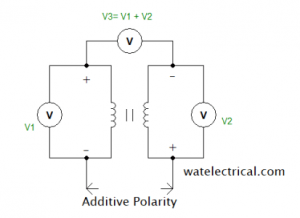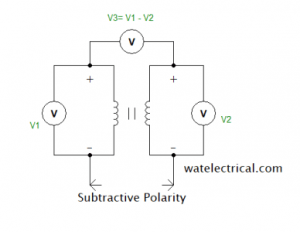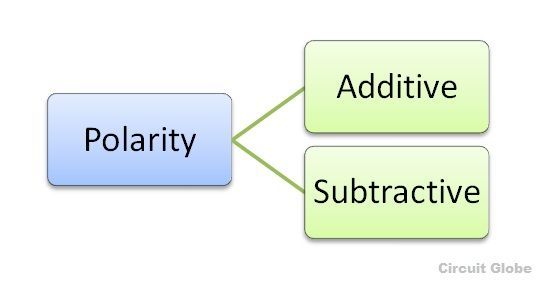AC MACHINES-1 (66761) Theory
9. Understand the principle of parallel operation of transformer.
9.1. Describe the purpose of polarity test.
What is the use of polarity test?
Two Types of Polarity Testing of Transformer
- Additive, and
- Subtractive
Additive Polarity
The voltmeters V1 and V2 are connected across the primary and secondary windings of the transformer. The voltmeter V1 measures the voltage across the primary winding whereas voltmeter V2 measures the voltage across the secondary winding respectively. Apart from these two voltmeters, a third voltmeter V3 is connected across both the windings I,e primary winding and secondary winding. If V3 reads voltage as the summation of both V1 and V2 then, it is an additive type.
The polarity of the primary winding and the secondary winding is different. The terminals A1 and B2 have the same polarity whereas A2 and B1 have the same polarity. The figure which explains the Additive type polarity is shown in the figure below.

Additive Polarity
Subtractive Polarity
The voltmeters V1 and V2 are connected across the primary and secondary windings of the transformer. The voltmeter V1 measures the voltage across the primary winding whereas voltmeter V2 measures the voltage across the secondary winding respectively. Apart from these two voltmeters, a third voltmeter V3 is connected across both the windings I,e primary winding and secondary winding. If V3 reads voltage as the difference of both V1 and V2 then, it is as subtractive type.

Subtractive Polarity
Polarity Test of Transformer
Polarity means the direction of the induced voltages in the primary and the secondary winding of the transformer. If the two transformers are connected in parallel, then the polarity should be known for the proper connection of the transformer. There are two types of polarity one is Additive, and another is Subtractive.

Subtractive Polarity: In subtractive polarity, different terminals of the primary and secondary side of the transformer is connected.
Explanation With Connection Diagram
Each of the terminals of the primary, as well as the secondary winding of a transformer, is alternatively positive and negative with respect to each other as shown in the figure below. Let A1 and A2 be the positive and negative terminal, respectively of the primary side of the transformer and a1, a2 are the positive and negative terminal of the secondary side of the transformer.
If A1 is connected to a1 and A2 is connected to a2 that means similar terminals of the transformer are connected, then the polarity is said to be additive. If A1 is connected to a2 and A2 to a1, that means the opposite terminals are connected to each other, and thus the voltmeter will read the subtractive polarity.

It is essential to know the relative polarities at any instant of the primary and the secondary terminals for making the correct connections if the transformers are to be connected in parallel or they are used in a three-phase circuit.
In the primary side, the terminals are marked as A1 and A2 and from the secondary side, the terminals are named as a1 and a2. The terminal A1 is connected to one end of the secondary winding, and a voltmeter is connected between A2 and the other end of the secondary winding.
When the voltmeter reads the difference that is (V1 – V2), the transformer is said to be connected with opposite polarity know as subtractive polarity and when the voltmeter reads (V1 + V2), the transformer is said to have additive polarity.
Steps to Perform Polarity Test
- Connect the circuit as shown in the above circuit diagram figure and set the autotransformer to zero position.
- Switch on the single-phase supply
- Record the values of the voltages as shown by the voltmeter V1, V2 and V3.
- If the reading of the V3 shows the addition of the value of V1 and V2 that is V2 = V1+V2 the transformer is said to be connected in additive polarity.
- If the reading of the V3 is the subtraction of the readings of V1 and V2, then the transformer is said to be connected in subtractive or negative polarity.
This is all about polarity test of transforme
